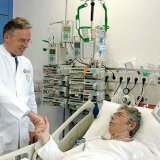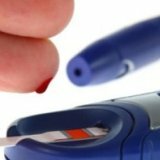How do elderly people suffer from thyroid gland diseases?
 Elderly people often suffer from thyroid disorders. The main problem is the difficulty of timely recognition. This happens for several reasons. About this and many other things in our article.
Elderly people often suffer from thyroid disorders. The main problem is the difficulty of timely recognition. This happens for several reasons. About this and many other things in our article.
The diagnosis
The first reason lies in the fact that the elderly usually have a "bunch" of different diseases, which causes them to see a doctor, usually a disease of some other organ, to which the doctor and focuses all his attention. The second reason is that the symptoms of thyroid diseases are often similar to the manifestations of other diseases, which leads to an error in diagnosis. In addition, in the elderly, the patient may not have typical signs of thyroid disease.
All this makes the doctor often prescribe a thyroid function test even in the absence of clinical signs of the disease. At the same time it may be a new problem, if it turns out that the study shows the increase in thyroid stimulating hormone of pituitary and thyroid hormone levels are stored in the normal range, that is, iron is enough, but the enhanced stimulation. Until now, there is no consensus among physicians on what to do in this case - whether to prescribe thyroid hormones immediately or wait until the levels of thyroid hormones become below normal values.
In addition, often there are errors in the diagnosis of thyroid disorders in the elderly after the interpretation of research. Some diseases, which are more common in old age, can distort the results of laboratory research. So, with alimentary dystrophy, diabetes mellitus, severe liver and heart disease, there is a temporary drop in the T4 level, which can be regarded as hypothyroidism.
A number of drugs often taken by elderly patients can influence the results of ongoing research;Among them:
- preparations for the treatment of epilepsy: carbamazine and diphenylhydantoin cause rapid destruction of the retireoid hormones in the liver and a decrease in their level in the blood;
- aspirin reduces the binding of thyroid hormones to blood proteins and reduces the level of total T4;
- similarly acts as a medicine for the treatment of arthritis, for example, prednisolone;
- medications that normalize the heart rhythm, for example, amiodarone, can reduce or increase the level of thyroid hormones;
- drug heparin can cause a temporary rise in T4, displacing it from the blood proteins.
Very difficult and clinical diagnosis of hypothyroidism in the elderly. Judge for yourself:
- slowing down thinking processes;
- decreased physical activity;
- body temperature decrease;
- chilliness;
- constipation;
- compaction of artery walls;
- increase in cholesterol;
- increase in body weight;
- lifting of blood pressure;
- anemia;
- muscle spasms;
- dry skin.
On the one hand, these are natural signs of aging, on the other - symptoms of hypothyroidism.
In addition, the elderly may have signs that go away from the diagnosis of hypothyroidism. For example, hand trembling, weight loss due to poor nutrition, increased nervousness, that is, signs indicating an increase in thyroid function, rather than a decrease in it. Many elderly people with hypothyroidism have a normal thyroid gland.
Therefore, the main method of diagnosis remains to study the function of the thyroid gland. In the clinical form of hypothyroidism, there is an increase in the level of TSH and a decrease in free T4.With subclinical hypothyroidism, there is only an increase in TSH.As already noted earlier, there are some disagreements regarding the treatment of this group of patients. One of the most common approaches is the following: if the level of TSH does not exceed 10( the norm of c-5), thyroxin should be prescribed only to patients who do not complain of angina pectoris.
Additional factors that may prompt the physician to prescribe thyroid hormones may be the presence of insulin dependent diabetes mellitus, pernicious anemia, rheumatoid arthritis or premature hair loss in the patient, as the likelihood of hypothyroidism soon becoming a clinical form is very high. If the patient has antibodies to the components of the thyroid tissue, the appointment of thyroxin is also advisable, as the functional activity of the gland can be expected to rapidly fade. With a high level of cholesterol, the intake of thyroid-stimulating hormones can also have a beneficial effect, normalizing its content in the blood.
If a patient is scheduled to receive thyroid hormones, it is important that the treatment starts at a very low dose( eg 25 mg) and increases by the same amount every 4-6 weeks until the upper level of normal TSH values is reached. Excessive amount of the drug can provoke pain in the heart, increase shortness of breath, palpitation, and also lead to increased irritability and intolerance to the heat.
An important problem in drug therapy for elderly hypothyroidism, as well as in other diseases, is that they often forget to take medications. Make sure that this does not happen.
Monitor the adequacy of the dose every six months, determining the levels of TSH and free T4.
Features of the course of hyperthyroidism in the elderly
Increased thyroid function in the elderly develops much less than hypothyroidism. As with githyroidism, the symptoms of thyrotoxicosis can easily be confused with normal signs of aging. Here are some of them:
- hand tremor;
- weight loss;
- infringement of a warm rhythm;
- heart failure;
- heat intolerance;
- sweating;
- feeling tired and weak.
These manifestations can occur in the elderly both in hyperthyroidism and in the absence of it.
At the same time, older people may have signs that are not at all characteristic of hyperthyroidism: apathy, inhibition, depression, their weight may increase. In many elderly people, hyperthyroidism can be without enlarging the size of the thyroid gland.
Sometimes the first sign of thyrotoxicosis in the elderly, which is diagnosed, is a violation of the heart rate. Therefore, if you suddenly have a heart rhythm disturbance and your doctor says that you have atrial fibrillation, discuss with him the question of whether to study the function of the thyroid gland.
Another important feature of hyperthyroidism at this age is the change in bone tissue, namely a decrease in its density, which is much more pronounced than in elderly people without thyrotoxicosis, and bone fractures are noted in them much more often.
The laboratory examination of thyroid function and in this case is the main method of establishing a diagnosis. If there is hyperthyroidism - increased the free level of T4 and reduced the level of TSH.Sometimes the T4 level is normal, but T3 is elevated, which is more frequent with a node producing excessive amounts of hormones.
The method of choice in the treatment of hyperthyroidism in most countries of the West and the United States is the use of radioactive iodine. In our country, for diffuse toxic goiter, conservative treatment with antithyroid drugs is most often used, and for hyperfunctioning nodes, surgical treatment is used.
Stay healthy!



